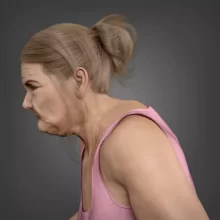Children Are the Most Susceptible to Meningitis, so These 8 Symptoms Are What Every Parent Should Keep an Eye Out For
The post Children Are the Most Susceptible to Meningitis, so These 8 Symptoms Are What Every Parent Should Keep an Eye Out For appeared first on Healthy Holistic Living.
Bacterial meningitis is the most serious type of meningitis. It can lead to death or permanent disability. It is a medical emergency.
Meningitis affects the meninges, the membranes that surround the brain and spinal cord and protect the central nervous system (CNS), together with the cerebrospinal fluid.
In 2006, the mortality rate for bacterial meningitis was 34 percent, and 50 percent of patients experienced long-term effects after recovery.
Several types of bacteria can cause bacterial meningitis, including Streptococcus pneumoniae (S. pneumoniae) and Group B Streptococcus.
Other types of meningitis include viral, parasitic, fungal, and non-infectious meningitis, but the bacterial type is the most severe.
Everything You Should Know About Meningitis
The United States (U.S.) from 2003 to 2007, there were around 4,100 cases of bacterial meningitis each year, of which about 500 were fatal.
Bacterial type is the second most common type viral meningitis, but it is more serious.
Infants are at high risk of bacterial meningitis, and it spreads easily in places where many people gather, such as college campuses.
Early signs include a fever and stiff neck, headache, nausea, vomiting, confusion, and increased sensitivity to light. Immediate medical attention is essential.
Causes and risk factors
Meningitis is an inflammation of the meninges that cover the brain.
Haemophilus influenzae (H. influenzae) type B (Hib)
Neisseria meningitides (N. meningitides)
Streptococcus pneumoniae (S. pneumonia)
Listeria monocytogenes (L. monocytogenes
Group B Streptococcus
At different ages, people are more likely to be affected by different strains.
The bacteria that cause meningitis usually pass from one person to another, for example, through droplets in coughs and sneezes or through saliva or spit. Some types can spread through food.
Group B streptococcus can pass from mothers to newborns during delivery.
Some people are carriers. They have the bacteria, but they do not develop symptoms. Living in a house with either a carrier or someone who has meningitis increases the risk.
Risk factors
Bacterial meningitis can happen at any age, but infants are more susceptible.
Other factors that increase the risk include:
an anatomical defect or trauma, such as a skull fracture, and some kinds of surgery, if these allow a way for bacteria to enter the nervous system
an infection in the head or neck area
spending time in communities, for example, at school or college
living in or traveling to certain locations, such as sub-Saharan Africa
having a weakened immune system, due to a medical condition or treatment
working in laboratories and other settings where meningitis pathogens are present
Recurrent bacterial meningitis is possible but rare. Studies show that 59 percent of recurrent cases are due to anatomical defects, and 36 percent occur in people with a weakened immune system.
Symptoms
According to the Centers for Disease Control and Prevention (CDC), the symptoms of meningitis can appear either suddenly or over a few days. They normally emerge in 3 to 7 days after infection.
Early symptoms of meningitis include:
nausea and vomiting
fever
headache and a stiff neck
muscle pain
sensitivity to light
confusion
cold hands or feet and mottled skin
in some cases, a rash that does not fade under pressure
Later symptoms include seizures and coma.
Infants may:
breathe quickly
refuse feeds and be irritable
cry excessively, or give a high-pitched moan
be stiff, with jerky movements, or listless and floppy
The fontanelle may be bulging.
Meningitis rash glass test
A meningitis rash occurs if blood leaks into the tissue under the skin.
It may start as a few small spots in any part of the body, then spread rapidly and look like fresh bruises.
The glass test can assist in identifying a meningeal rash.
Press the side of a drinking glass firmly against the rash.
If the rash fades and loses color under pressure, it is not a meningitis rash.
If it does not change color, you should contact a doctor immediately.
The rash or spots may fade and then come back.
Treatment
Antibiotics: These are usually given intravenously.
Corticosteroids: These may be given if inflammation is causing pressure in the brain, but studies show conflicting results.
Acetaminophen, or paracetamol: Together with cool sponge baths, cooling pads, fluids, and room ventilation, these reduce fever.
Anticonvulsants: If the patient has seizures, an anticonvulsant, such as phenobarbital or Dilantin, may be prescribed.
Oxygen therapy: Oxygen will be administered to assist with breathing.
Fluids: Intravenous fluids can prevent dehydration, especially if the patient is vomiting or cannot drink.
Sedatives: These will calm the patient if they are irritable or restless.
Blood tests may be used to monitor the patient’s levels of blood sugar, sodium, and other vital chemicals.
Is There Anything You Can Do To Help Relieve Symptoms?
Editor’s Note: There are a number of home remedies that can help alleviate the uncomfortable symptoms of meningitis while your medical team is treating the sufferer. You should always consult your healthcare provider about complementary remedies before you begin them. Simple techniques that can help bring temporary relief include:
cool washcloths applied to the forehead to help reduce fever
plenty of rest
coconut water to help prevent loss of electrolytes and dehydration
ginger tea to help hydrate and relieve body pain (it can also alleviate nausea)
an essential oil massage using peppermint oil, cinnamon oil or cayenne oil along with your carrier oil of choice can help relieve muscle pain
To prevent the spread of bacterial meningitis and other diseases, it is important to practice good hygiene, such as frequent handwashing. Being aware of the signs and symptoms of bacterial meningitis will make it easier to take immediate action can be taken if necessary. If you have young children, we encourage you to consult your healthcare provider about your options for reducing their risk of catching meningitis before it becomes a reality.
This article is shared with permission from our friends at Medical News Today.
The post Children Are the Most Susceptible to Meningitis, so These 8 Symptoms Are What Every Parent Should Keep an Eye Out For appeared first on Healthy Holistic Living.












